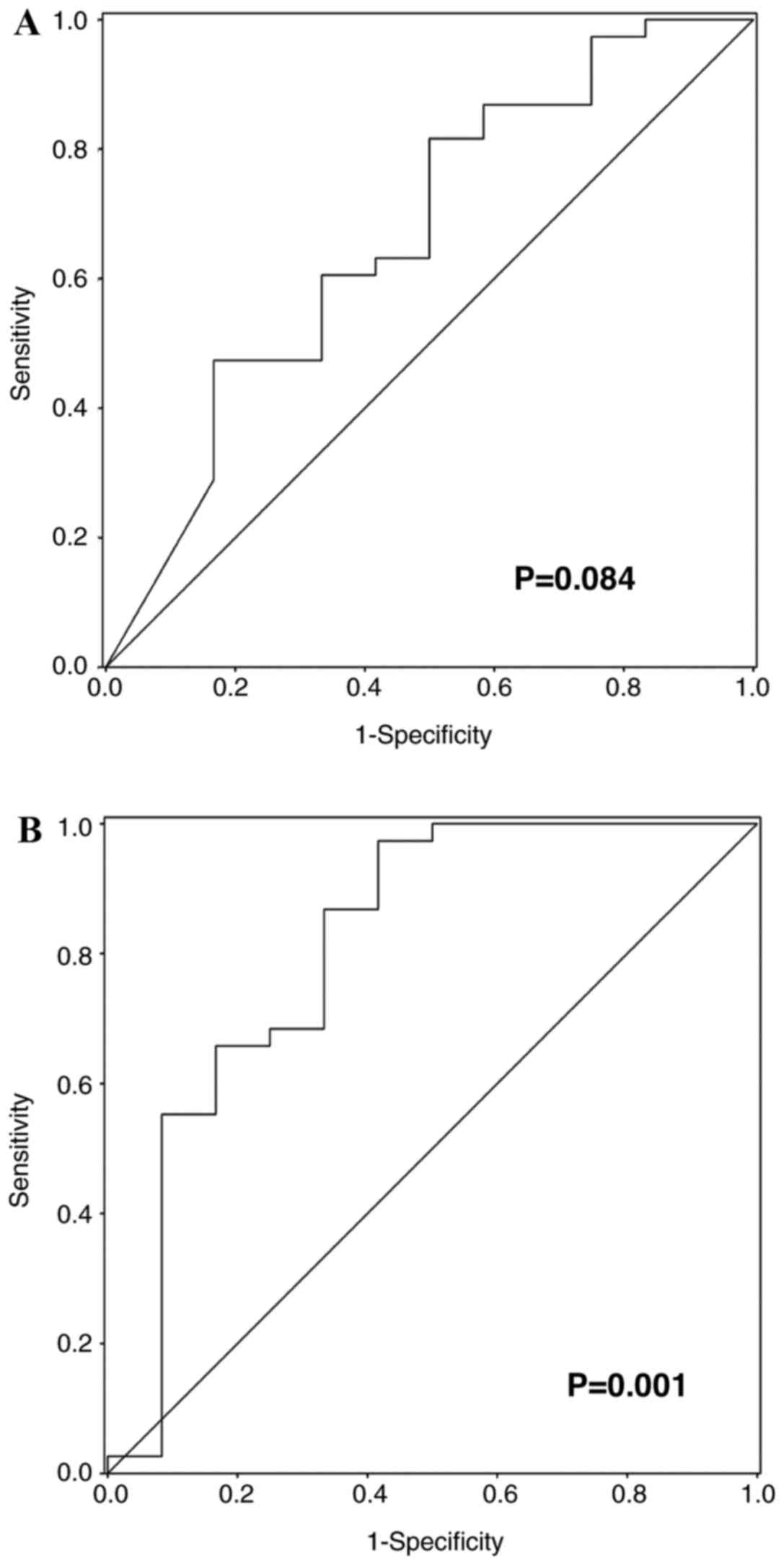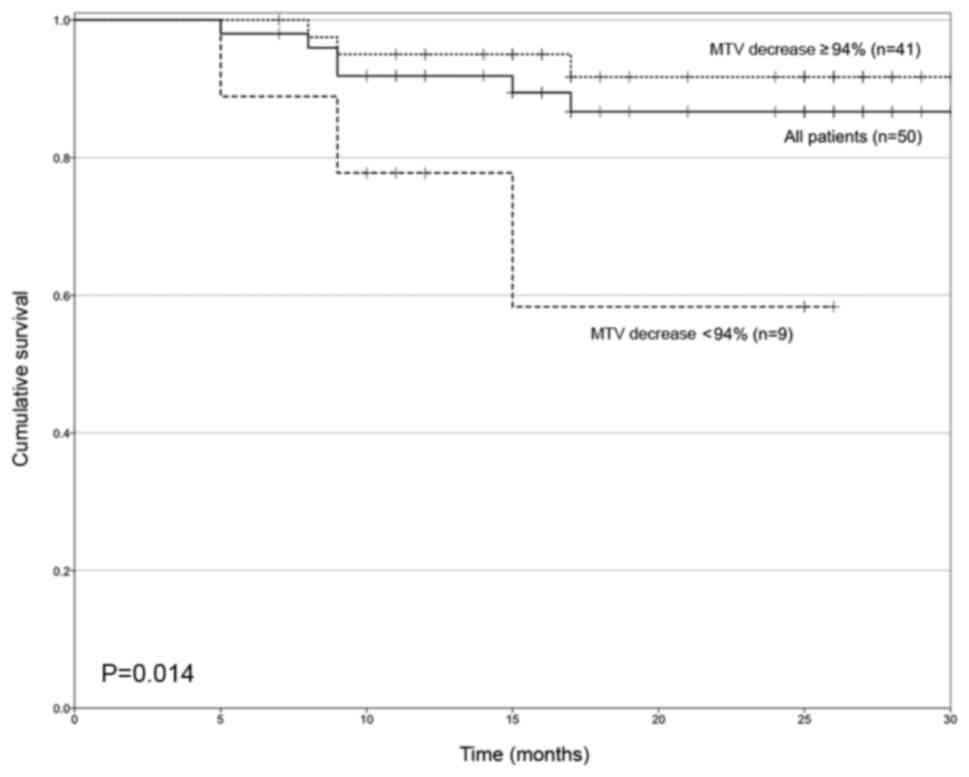|
1
|
Ferlay J, Soerjomataram I and Ervik M:
GLOBOCAN 2012 v1.0, Cancer Incidence and Mortality Worldwide: IARC
Cancer Base No. 11. International Agency for Research on Cancer.
Lyon, France; 2013
|
|
2
|
Zelenetz AD, Gordon LI, Wierda WG,
Abramson JS, Advani RH, Andreadis CB, Bartlett N, Byrd JC, Czuczman
MS, Fayad LE, et al: Non-Hodgkin's lymphomas, version 4.2014. J
Natl Compr Canc Netw. 12:1282–1303. 2014. View Article : Google Scholar : PubMed/NCBI
|
|
3
|
Candelaria M: Advances in diagnosis and
control of lymphomas. Salud Publica Mex. 58:296–301. 2016.
View Article : Google Scholar : PubMed/NCBI
|
|
4
|
International Non-Hodgkin's Lymphoma
Prognostic Factors Project: A predictive model for aggressive
non-Hodgkin's Lymphoma. N Engl J Med. 329:987–994. 1993. View Article : Google Scholar : PubMed/NCBI
|
|
5
|
Sehn LH, Berry B, Chhanabhai M, Fitzgerald
C, Gill K, Hoskins P, Klasa R, Savage KJ, Shenkier T, Sutherland J,
et al: The revised international prognostic index (R-IPI) is a
better predictor of outcome than the standard IPI for patients with
diffuse large B-cell lymphoma treated with R-CHOP. Blood.
109:1857–1861. 2007. View Article : Google Scholar : PubMed/NCBI
|
|
6
|
Cheson BD, Pfistner B, Juweid ME, Gascoyne
RD, Specht L, Horning SJ, Coiffier B, Fisher RI, Hagenbeek A, Zucca
E, et al: Revised response criteria for malignant lymphoma. J Clin
Oncol. 25:579–586. 2007. View Article : Google Scholar : PubMed/NCBI
|
|
7
|
Park S, Moon SH, Park LC, Hwang DW, Ji JH,
Maeng CH, Cho SH, Ahn HK, Lee JY, Kim SJ, et al: The impact of
baseline and interim PET/CT parameters on clinical outcome in
patients with diffuse large B cell lymphoma. Am J Hematol.
87:937–940. 2012. View Article : Google Scholar : PubMed/NCBI
|
|
8
|
Oken MM, Creech RH, Tormey DC, Horton J,
Davis TE, McFadden ET and Carbone PP: Toxicity and response
criteria of the Eastern Cooperative Oncology Group. Am J Clin
Oncol. 5:649–655. 1982. View Article : Google Scholar : PubMed/NCBI
|
|
9
|
Cheson BD, Fisher RI, Barrington SF,
Cavalli F, Schwartz LH, Zucca E, Lister TA; Alliance, Australasian
Leukaemia and Lymphoma Group; Eastern Cooperative Oncology Group;
European Mantle Cell Lymphoma Consortium; et al: Recommendations
for initial evaluation, staging, and response assessment of Hodgkin
and non-Hodgkin lymphoma: The Lugano classification. J Clin Oncol.
32:3059–3068. 2014. View Article : Google Scholar : PubMed/NCBI
|
|
10
|
Olszewski AJ, Winer ES and Castillo JJ:
Validation of clinical prognostic indices for diffuse large B-cell
lymphoma in the National Cancer Data Base. Cancer Causes Control.
26:1163–1172. 2015. View Article : Google Scholar : PubMed/NCBI
|
|
11
|
Meignan M, Gallamini A, Meignan M,
Gallamini A and Haioun C: Report of the first international
workshop on interim-PET-Scan in lymphoma. Leuk Lymphoma.
50:1257–1260. 2009. View Article : Google Scholar : PubMed/NCBI
|
|
12
|
Juweid ME, Stroobants S, Hoekstra OS,
Mottaghy FM, Dietlein M, Guermazi A, Wiseman GA, Kostakoglu L,
Scheidhauer K, Buck A, et al: Use of positron emission tomography
for response assessment of lymphoma: Consensus of the imaging
subcommittee of international harmonization project in lymphoma. J
Clin Oncol. 25:571–578. 2007. View Article : Google Scholar : PubMed/NCBI
|
|
13
|
Fuertes S, Setoain X, Lopez-Guillermo A,
Carrasco JL, Rodríguez S, Rovira J and Pons F: Interim FDG PET/CT
as a prognostic factor in diffuse large B-cell lymphoma. Eur J Nucl
Med Mol Imaging. 40:496–504. 2013. View Article : Google Scholar : PubMed/NCBI
|
|
14
|
Yang DH, Ahn JS, Byun BH, Min JJ, Kweon
SS, Chae YS, Sohn SK, Lee SW, Kim HW, Jung SH, et al: Interim
PET/CT-based prognostic model for the treatment of diffuse large
B-cell lymphoma in the post-rituximab era. Ann Hematol. 92:471–479.
2013. View Article : Google Scholar : PubMed/NCBI
|
|
15
|
Gallicchio R, Mansueto G, Simeon V,
Nardelli A, Guariglia R, Capacchione D, Soscia E, Pedicini P,
Gattozzi D, Musto P and Storto G: F-18 FDG PET/CT quantization
parameters as predictors of outcome in patients with diffuse large
B-cell lymphoma. Eur J Haematol. 92:382–389. 2014. View Article : Google Scholar : PubMed/NCBI
|
|
16
|
Itti E, Lin C, Dupuis J, Paone G,
Capacchione D, Rahmouni A, Haioun C and Meignan M: Prognostic value
of interim 18-FDG PET in patients with diffuse large B-cell
lymphoma: SUV-based assessment at 4 cycles of chemotherapy. J Nucl
Med. 50:527–533. 2009. View Article : Google Scholar : PubMed/NCBI
|
|
17
|
Dührsen U, Hüttmann A, Jöckel KH and
Müller S: Positron emission tomography guided therapy of aggressive
non-Hodgkin lymphoma- the PETAL trial. Leuk Lymphoma. 50:1757–1760.
2009. View Article : Google Scholar : PubMed/NCBI
|
|
18
|
Safer V, Dupus J, Itti E, Jardin F,
Fruchart C, Bardet S, Véra P, Copie-Bergman C, Rahmouni A, Tilly H,
et al: Interim [18F]Fluorodeoxyglucose positron emission tomography
scan in diffuse large B-cell lymphoma treated with
anthracycline-based chemotherapy plus rituximab. J Clin Oncol.
30:184–190. 2012. View Article : Google Scholar : PubMed/NCBI
|
|
19
|
Moskowitz CH, Schöder H, Teruya-Feldstein
J, Sima C, Iasonos A, Portlock CS, Straus D, Noy A, Palomba ML,
O'Connor OA, et al: Risk adapted dose-dense immunochemotherapy
determined by interim FDG-PET in advanced-stage diffuse large
B-cell lymphoma. J Clin Oncol. 28:1896–1903. 2010. View Article : Google Scholar : PubMed/NCBI
|
|
20
|
Itti E, Juweid ME, Haioiun C, Yedes I,
Hamza-Maaloul F, El Bez I, Evangelista E, Lin C, Dupuis J and
Meignan M: Improvement of early 18F-FDG PET interpretation in
diffuse large B-cell lymphoma: Importance of the reference
background. J Nucl Med. 51:1857–62. 2010. View Article : Google Scholar : PubMed/NCBI
|
|
21
|
Kwon SH, Kang DR, Kim J, Yoon JK, Lee SJ,
Jeong SH, Lee HW and An YS: Prognostic value of negative interim
2-[18F]-fluoro-2-deoxy-d-glucose PET/CT in diffuse large B-cell
lymphoma. Clin Radiol. 71:280–286. 2016. View Article : Google Scholar : PubMed/NCBI
|
|
22
|
Cox MC, Ambrogi V, Lanni V, Cavalieri E,
Pelliccia S, Scopinaro F, Monarca B, Marchetti P and Spiriti MA:
Use of interim [18F] fluorodeoxyglucose-positron emission
tomography is not justified in diffuse large B-cell lymphoma during
first-line immunochemotherapy. Leuk Lymphoma. 53:263–269. 2012.
View Article : Google Scholar : PubMed/NCBI
|
|
23
|
Cashen AF, Dehdashti F, Luo J, Homb A,
Siegel BA and Bartlett NL: 18F-FDG PET/CT for early response
assessment in diffuse large-B cell lymphoma: Poor predictive value
of international harmonization project interpretation. J Nucl Med.
52:386–392. 2011. View Article : Google Scholar : PubMed/NCBI
|
|
24
|
Teresawa T, Lau J, Bardet S, Couturier O,
Hotta T, Hutchings M, Nihashi T and Nagai H:
Fluorine-18-fluorodeoxyglucose positrón emission tomography for
interim response assessment of advance-stage Hodgkin lymphoma and
diffusse large B-cell lymphoma: A systematic review. J Clin Oncol.
27:1906–1914. 2009. View Article : Google Scholar : PubMed/NCBI
|
|
25
|
Spaepen K, Stroobants S, Dupont P, Bormans
G, Balzarini J, Verhoef G, Mortelmans L, Vandenberghe P and de
Wolf-Peeters C: [18]FDG PET monitoring of tumor response to
chemotherapy: [(18)F]FDG uptake correlate with the viable tumor
cell fraction? Eur J Nucl Med Mol Imaging. 30:682–688. 2003.
View Article : Google Scholar : PubMed/NCBI
|
|
26
|
Barrington SF and Johnson PWM: FDG-PET CT
in lymphoma: Has imaging-directed personalized medicine become a
reality? J Nucl Med. 58:1539–1544. 2017. View Article : Google Scholar : PubMed/NCBI
|













